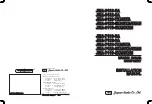
190-00906-01
GTX 23 Installation Manual
Rev. C
Page B-5
Secondary Method:
Solder a Flat Braid (Item 6) to the shield exposed through the window of the prepared cable assembly
(Item 4). Ensure a solid electrical connection through the use of acceptable soldering practices. Use
care to avoid applying excessive heat that burns through the insulation of the center conductors and
shorts the shield to the signal wire. Slide a minimum 0.75 inches of Teflon heat shrinkable tubing
(Item 5) onto the prepared wire assembly and shrink using a heat gun. The chosen size of heat
shrinkage tubing must accommodate both the number of conductors present in the cable and the Flat
Braid (Item 6) to be attached.
Teflon Heat Shrinkable Tubing:
Reference the following MIL-Spec for Teflon heat shrinkable tubing (M23053/5-X-Y).
4. At the same end of the shielded cable (Item 4) and ahead of the previous shield termination, strip
back “Float Min” to “Float Max” (Table B-2) length of jacket and shield to expose the insulated
center conductors (Figure B-2). The “Ideal Float” length may be best to build optimally.
Preferred Method:
The jacket and shield should be cut off at the same point so no shield is exposed. Slide 0.75 inches
minimum of Teflon heat shrinkable tubing (Item 7) onto the cable and use a heat gun to shrink the
tubing. The chosen size of heat shrinkage tubing must accommodate the number of conductors present
in the cable.
Secondary Method:
Leave a max 0.35 inches of shield extending past the jacket. Fold this 0.35 inches of shield back over
the jacket. Slide a solder sleeve (Item 7) over the end of the cable and use a heat gun approved for
solder sleeves to secure the connection. The chosen size of solder sleeve must accommodate the
number of conductors present in the cable.
5. Strip back approximately 0.17 inches of insulation from each wire of the shielded cable (Item 4)
and crimp a contact (Item 8) to each conductor. It is the responsibility of the installer to determine
the proper length of insulation to be removed. Wire must be visible in the inspection hole after
crimping and the insulation must be 1/64 – 1/32 inches from the end of the contact as shown in
Figure B-3.
Figure B-3 Insulation/Contact Clearance














































